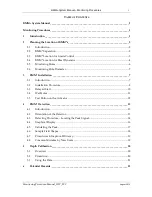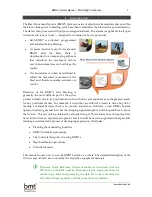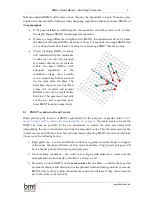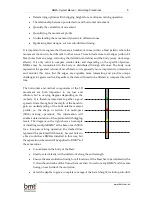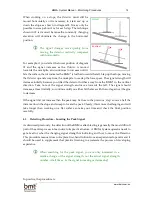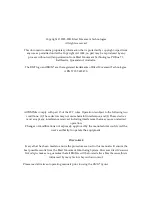
BMM
®
System
Manual
– Monitoring Procedures
13
www.bmt.com.au
4
BMM
®
D
ETECTION
4.1
Introduction
There is no substitute for experience when it comes to locating the BMM
®
s. This section
provides some basic techniques to get you started and fast-track that experience. When working
on a reasonably flat, well fragmented muckpile, the BMM
®
signal is reasonably easy to locate
but as the terrain gets steeper and rougher, locating the BMM
®
gets more challenging. In this
situation, the key is to take your time, use the technique specified and double check that you
have located the correct position (see Section 4.5).
One of the challenges for new users is to know what is a real signal from a BMM and what is
just environmental interference. You are looking for a signal that rises reasonably quickly and
consistently – unless the depth of the BMM
®
is approaching the limit of the
Detector
’s capability.
As you gain experience, you will sense when the signal is not right. As an analogy, you may be
stumbling around in the foothills instead of climbing the mountain. Usually, when you find the
mountain it will be obvious. As a general rule,
if you are not sure if you have located the
‘real’
signal, then you probably haven’t!
Following is a list of things to keep in mind when conducting a search:
a)
Where do you expect the BMM
®
s to be? Use your plan from the installation stage nd
there is also a GPS (low precision) map accessible on the detector.
b)
What signal strength do you expect? If you have been locating other similarly installed
BMM
®
s on say, Range 5 and you think you are close to the BMM
®
but on Range 12 then
the chances are, you are not at the right location — keep looking.
c)
If you are working on the side of a slope, you may be detecting the side of the field and
the interaction between the receiver and the field at this location is different to when
you are well above the level of the source.
4.2
Orientation of the Detector
The signal strength measured by the
Detector
is determined
by the distance from the transmitter and the angle between
the
Detector Coil
and the field lines radiating from the
transmitter. The peak signal will be when the
Detector
is
directly above the transmitter with the coil horizontal.
One variable can be eliminated by keeping the coil
horizontal at all times as in diagrams
and
. This is
critical when conducting the final pin-pointing and
recording the ultimate signal strength, although it is not
necessary to be perfect when conducting the initial traverse
of the muckpile to get close to the BMM
®
.
Correct
Incorrect


